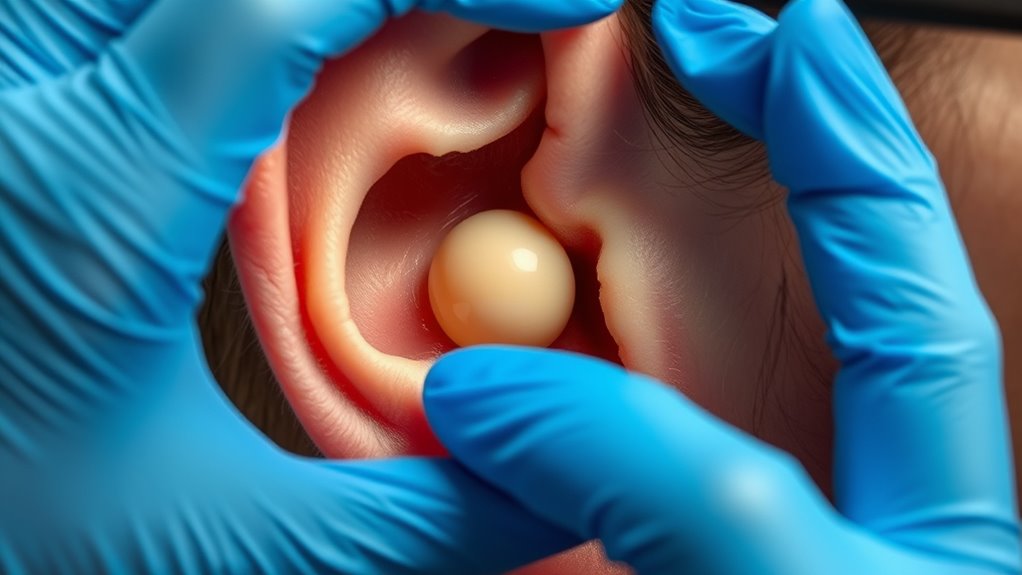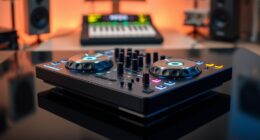To get your ear impressions, a specialist inserts a soft, silicone-based material into your ear, gently filling the contours to capture every detail. You’ll feel some slight pressure but remain comfortable during the quick process. Once the material sets, they carefully remove it, creating a precise replica of your ear. This impression is then used to create custom molds. Keep going to discover the detailed steps that guarantee a perfect fit for your ear-device needs.
Key Takeaways
- The specialist inserts a soft, silicone-based impression material into the ear to capture its unique contours.
- The material sets quickly, creating a detailed replica of the ear’s outer and inner anatomy.
- The impression is carefully removed, ensuring all intricate ear details are preserved.
- The impressions are sent to a lab where durable molds are crafted for custom ear devices.
- The final molds are fitted into the ear, with adjustments made for comfort and optimal performance.

Have you ever wondered how custom ear products, like hearing aids or earplugs, fit so perfectly? The answer lies in the precise process of creating ear impressions. When you visit an audiologist or hearing specialist, they’ll start by selecting the appropriate impression materials. These materials are specially designed to capture every contour of your ear canal and outer ear with high accuracy. The impression process begins with the specialist inserting a soft, pliable substance—often a silicone-based material—into your ear. You might feel a slight pressure, but it’s generally comfortable and quick. As the impression material fills your ear, it begins to mold itself to your unique ear shape, capturing all the intricate details.
Once the impression material has set, the specialist carefully removes it from your ear. The result is a precise replica of your ear canal and outer ear, which will be used to craft your custom ear molds. These molds are essential for ensuring a snug and effective fit for devices like hearing aids or earplugs. The impression allows manufacturers to design products tailored specifically to your ear anatomy, improving comfort, sound quality, and stability. The key to this process’s success is the quality of the impression materials used—they must be safe, non-toxic, and capable of capturing fine details without distortion. High-quality impression materials are flexible enough to adapt to the ear’s complex curves but sturdy enough to hold their shape until removal.
After your ear impression has been taken, it’s sent to a lab for processing. Here, technicians evaluate the impression for accuracy before casting the custom ear molds. These molds are often made from durable acrylic or silicone, depending on your needs. When the molds are ready, your audiologist will fit them into your ears, ensuring they’re comfortable and secure. Because each impression is unique, your custom ear molds will be designed to fit perfectly, minimizing discomfort and maximizing effectiveness. This personalized approach ensures your hearing aids or earplugs stay in place, provide optimal sound quality, and are comfortable enough for extended wear. An important aspect of the process is the quality of the impression materials used—they must be safe, non-toxic, and capable of capturing fine details without distortion. KTM electric dirt bikes are a good example of how high-performance, custom-designed products depend on precise manufacturing techniques. The entire process might seem simple, but it’s this meticulous attention to detail—using precise impression materials and careful handling—that guarantees a perfect fit for your ear products.
Frequently Asked Questions
How Long Does the Ear Impression Process Typically Take?
The ear impression process usually takes about 15 to 30 minutes. You’ll sit comfortably while the technician inserts impression material into your ear canal. The material molds to your ear’s shape, capturing details for a perfect fit. Once the impression material sets, they carefully remove it. This quick, straightforward process guarantees your custom ear protection or hearing device fits snugly and comfortably.
Are There Any Risks or Side Effects Involved?
Think of your ear canal as a delicate garden, where safety and care keep everything thriving. Usually, ear impressions are safe, but there’s a small risk of allergic reactions or discomfort if the materials aren’t compatible. To protect your garden, make certain a professional uses hypoallergenic substances and practices ear canal safety. While rare, these side effects can occur, so staying informed helps you maintain a healthy, happy ear environment.
How Should I Prepare for My Ear Impression Appointment?
To prepare for your ear impression appointment, avoid ear cleaning with cotton swabs a few days beforehand, as clean ears can help the process go smoothly. If you’re prone to allergies, take allergy precautions by informing your provider and possibly taking an antihistamine. Make sure your ears are dry and free of any infections or irritation. Wearing comfortable clothing and arriving on time also help guarantee a stress-free experience.
Can I Get Multiple Impressions for Different Devices?
Yes, you can get multiple impressions for different devices. When you request custom ear molds, let your audiologist know you need impressions for various devices like hearing aids or earplugs. This way, they can take multiple impressions in one appointment or schedule separate sessions. Always communicate your needs clearly, and your provider will guarantee each impression is accurate for each specific device, giving you a perfect fit every time.
How Long Do Ear Impressions Usually Last?
Your ear impressions typically last about 1 to 2 years, like a gentle whisper of your unique ear canal. However, due to ear canal sensitivity and the impression material’s safety, they can sometimes need renewal sooner. Regular check-ups ensure your impressions remain comfortable and safe, preventing any discomfort or damage. Trust your audiologist to guide you on the ideal time to refresh your impressions for continued comfort and safety.
Conclusion
Think of ear impressions as crafting a tiny, perfect mold of your unique landscape. Just as an artist carefully shapes each stroke to capture beauty, you trust the process to create a precise impression. When you follow each step, you’re guiding a skilled hand to capture your individuality. In the end, this small act becomes a gateway to personalized comfort and sound, turning your ear into a masterpiece that’s uniquely yours—crafted with care, just like a work of art.











